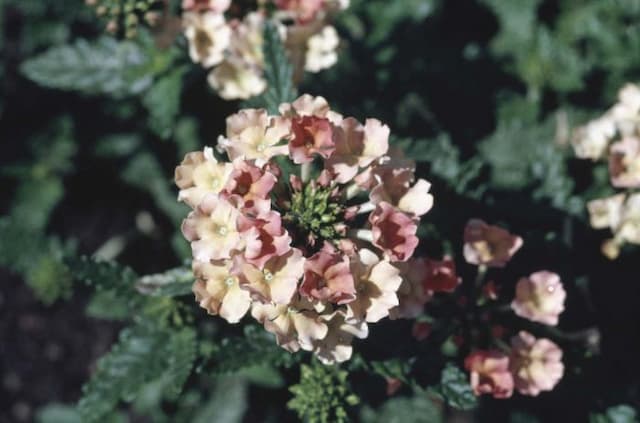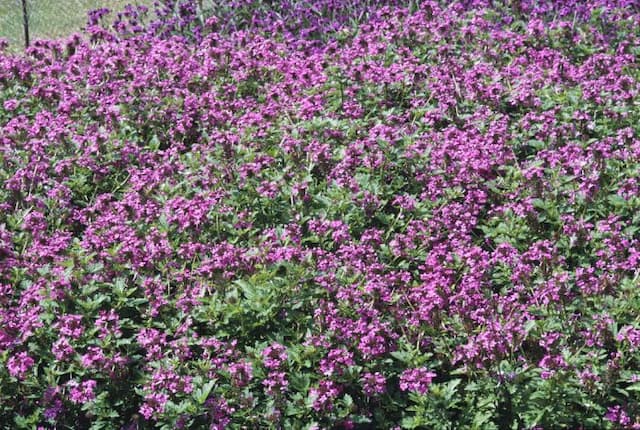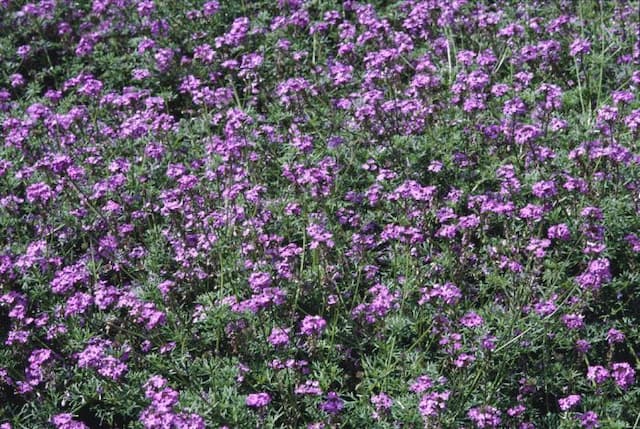Brazilian Vervain Verbena bonariensis 'Lollipop' (PBR)

ABOUT
Verbena bonariensis 'Lollipop' is a popular perennial plant known for its striking flower display and compact habit. This plant is characterized by its small clusters of tiny, tubular flowers that come in a vibrant purple hue, providing a rich source of nectar for butterflies and other pollinators. The flowers are perched gracefully atop slender, erect stems which are strong and wiry. Adding to its charm, the plant has a bushy clump of narrow, lance-shaped leaves that are usually a mid-green color, lending a fine texture to the foliage beneath the floating canopy of purple blooms. The leaves and stems together create an airy and open structure, allowing the plant to blend seamlessly with other plants in a mixed border or garden setting. Its blooms typically appear in the warmer months and can continue to add color and interest throughout the season.
About this plant
 Names
NamesFamily
Verbenaceae
Synonyms
Brazilian Vervain, Purpletop Vervain, Tall Verbena, Clustertop Vervain, Argentinian Vervain
Common names
Verbena bonariensis 'Lollipop' (PBR).
 Toxicity
ToxicityTo humans
The plant commonly known as Verbena is generally considered safe and non-toxic to humans. There is no well-documented evidence to suggest that Verbena causes significant poisoning when touched or ingested by humans. However, as with any plant, individual reactions can vary, and it is always possible for someone to have an allergic reaction. If an individual were to ingest a large amount of the plant and experience symptoms, it is important to seek medical advice.
To pets
The common Verbena plant is also not known to be toxic to pets. It is generally considered safe for dogs, cats, and other domestic animals. However, it's important to note that some pets might have a sensitive reaction or an allergy to the plant, which might cause mild gastrointestinal upset if they ingest it. If an animal exhibits unusual symptoms after ingesting Verbena, it is best to consult a veterinarian.
 Characteristics
CharacteristicsLife cycle
Perennials
Foliage type
Deciduous
Color of leaves
Green
Flower color
Purple
Height
2 feet [60 cm]
Spread
2 feet [60 cm]
Plant type
Herb
Hardiness zones
7
Native area
South America
Benefits
 General Benefits
General Benefits- Attracts wildlife: Verbena bonariensis 'Lollipop' is popular among pollinators such as bees, butterflies, and hummingbirds, providing them with valuable nectar sources.
- Low maintenance: This plant is known for being relatively carefree, requiring minimal upkeep once established in the right conditions.
- Drought tolerant: It is resilient to dry conditions, making it suitable for gardens in areas with less frequent rainfall.
- Long blooming period: The plant offers a lengthy flowering season, usually from mid-summer to early autumn, enhancing the garden's aesthetic for an extended time.
- Architectural interest: With its tall stems and cluster of purple flowers, it adds height and structure to garden designs.
- Versatile planting: It can be used in a variety of garden settings, including borders, containers, and as part of a mixed perennial bed.
- Easy to combine: The plant pairs well with other perennials and grasses, allowing for beautiful and diverse garden compositions.
- Self-seeding: Verbena bonariensis 'Lollipop' can self-seed under the right conditions, giving rise to new plants and helping to fill out garden spaces naturally.
 Medical Properties
Medical Properties- This plant is not used for medical purposes
 Air-purifying Qualities
Air-purifying QualitiesThis plant is not specifically known for air purifying qualities.
 Other Uses
Other Uses- Craft Material: The long stems and vibrant flowers of Verbena bonariensis can be dried and used in floral arrangements and craft projects for a pop of natural color.
- Educational Tool: The plant's clear differentiation between stems, leaves, and flowers make it an excellent specimen for botanical studies and educational purposes to demonstrate plant structure.
- Habitat Support: By planting Verbena bonariensis in a home garden, it can provide a habitat and breeding ground for beneficial insects like butterflies and bees, promoting biodiversity.
- Garden Design: Due to its tall and slim profile, Verbena bonariensis can be used as a living border or natural screen in garden designs, adding height and structure without taking up too much space.
- Photography: The striking appearance of Verbena bonariensis lends itself well as a subject for nature photography, helping enthusiasts practice macro and close-up shots.
- Eco-Friendly Confetti: The small flowers of Verbena bonariensis can be used as a biodegradable confetti alternative in outdoor celebrations, decomposing naturally without harming the environment.
- Natural Dyes: The flowers may be used to produce natural dyes for coloring textiles and art projects, offering an eco-friendly alternative to chemical dyes.
- Mood Enhancement: Incorporating Verbena bonariensis into a living or work space can provide a sense of well-being by adding a touch of nature and vibrant color, which may enhance mood and creativity.
- Seasonal Festivities: Its purple flowers can serve as a natural decoration for events and festivals, especially those occurring in the summer or fall when the plant typically blooms.
- Companion Planting: Verbena bonariensis can be planted alongside vegetable crops to attract pollinators, improving the yield of fruit and vegetable gardens.
Interesting Facts
 Feng Shui
Feng ShuiThe Verbena is not used in Feng Shui practice.
 Zodiac Sign Compitability
Zodiac Sign CompitabilityThe Verbena is not used in astrology practice.
 Plant Symbolism
Plant Symbolism- Healing: Verbena has been used throughout history in medicinal remedies and is often associated with healing and the restoration of health.
- Protection: In folklore, Verbena plants are believed to offer protection against harm and to ward off evil.
- Purity: The delicate structure of the Verbena flower has lent itself to association with purity and innocence.
- Enchantment: Sometimes linked to enchantment and magical practices, Verbena is thought to have been used by druids and sorcerers in their rituals.
- Harmony: The plant's propensity to attract pollinators such as butterflies symbolizes harmony with nature and the environment.
- Endurance: Verbena has a reputation for being tolerant and resilient, which can symbolize persistence and the ability to endure challenging circumstances.
- Creativity: The vibrant blossoms and the plant’s graceful form have made it a muse for artists and creative minds, signifying inspiration.
 Water
WaterThe 'Lollipop' Verbena, also commonly known as Purpletop Vervain, requires regular watering to maintain moist but not waterlogged soil. During the growing season, water the plant deeply once a week with about 1 gallon per plant, ensuring that water penetrates the root zone. In hot, dry weather, increase the frequency to twice a week. Reduce watering in the fall and winter when the plant is not actively growing. Always check the top inch of soil for dryness before watering again to prevent overwatering.
 Light
LightPurpletop Vervain thrives in full sun exposure, which means it needs at least six hours of direct sunlight each day. The best spot for this plant is in a location that receives ample morning light and protection from intense afternoon heat, although it can tolerate full sun all day if acclimated. Avoid heavily shaded areas as they can hinder the plant's growth and flowering.
 Temperature
TemperaturePurpletop Vervain prefers a temperate climate with ideal growing temperatures ranging from 60°F to 75°F. It can survive minimum temperatures of 20°F to 25°F but will die back to the root system when faced with frost. To ensure the health of the plant, avoid exposing it to extreme heat above 85°F for prolonged periods, which can cause stress.
 Pruning
PruningPrune Purpletop Vervain in early spring to stimulate new growth and encourage a bushier habit. Deadheading spent flowers can also promote additional blooming throughout the season. Perform a more substantial cut back in late autumn or early winter after the flowering has finished to maintain shape and size, removing up to one-third of the plant's height.
 Cleaning
CleaningAs needed
 Soil
SoilThe Brazilian vervain 'Lollipop' prefers well-draining soil with a peat-based or loamy mix and good fertility. Amend garden soil with compost or a balanced slow-release fertilizer. Ideal pH for Brazilian vervain 'Lollipop' ranges between 5.8 and 7.2, slightly acidic to neutral.
 Repotting
RepottingBrazilian vervain 'Lollipop' is typically planted in situ and doesn't require frequent repotting. If grown in containers, repot every 2-3 years or when it outgrows its pot to refresh the soil and accommodate root growth.
 Humidity & Misting
Humidity & MistingBrazilian vervain 'Lollipop' is adaptable to a variety of humidity conditions but thrives best in moderate humidity levels. It can tolerate some dry air but should not be exposed to excessively dry or humid environments for optimal growth.
 Suitable locations
Suitable locationsIndoor
Place in a bright spot with indirect light.
Outdoor
Full sun, protect from extreme cold.
Hardiness zone
7-11 USDA
 Life cycle
Life cycleVerbena bonariensis 'Lollipop' begins its life cycle when seeds are sown in early spring, germinating in warm soil. Following germination, seedlings emerge and grow into compact, bushy plants with strong stems and lance-shaped leaves. As the plant matures, clusters of small, fragrant, purple flowers develop atop tall, erect stems from mid-summer to early autumn, attracting pollinators such as butterflies and bees. After flowering, seeds form and are disbursed by wind or wildlife, enabling the cycle to repeat. In colder climates, Verbena 'Lollipop' may die back in winter, but it often self-seeds or can be propagated from cuttings to ensure its presence in the garden year after year. With proper care, including full sun exposure and well-draining soil, this perennial can thrive for several seasons, though it may be treated as an annual in very cold regions.
 Propogation
PropogationPropogation time
Spring-Early Summer
The Verbena bonariensis 'Lollipop' is commonly known as the Brazilian verbena, and the most popular method of propagation for this plant is by seed. The best time to sow the seeds is in late winter to early spring, usually around February to March, as the Brazilian verbena requires a warm temperature to germinate, typically around 70°F (approximately 21°C). Sowing should be done in a tray containing a light, well-draining seed starting mix. The seeds need to be lightly covered with soil or simply pressed into the surface, as they require light for germination. It is crucial to keep the soil moist but not waterlogged, and you can expect germination to occur within 2-4 weeks. Once the seedlings have developed a couple of sets of true leaves, they can be transplanted into individual pots and eventually moved outdoors when the risk of frost has passed.







![Vervain [Donalena Lavender Grace]](/_next/image?url=https%3A%2F%2Fplants-admin.emdemapps.com%2Fimages%2Fplants%2F%2Fimages%2F604b575c837e7.png&w=640&q=75)
